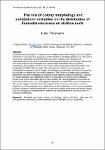The role of colony morphology and substratum inclination on the distribution of Eunicella verrucosa on shallow reefs
| dc.contributor.author | Thompson, L. | |
| dc.date.accessioned | 2023-12-22T16:14:06Z | |
| dc.date.available | 2023-12-22T16:14:06Z | |
| dc.date.issued | 2023 | |
| dc.identifier.citation |
Thompson, L. (2023) 'The role of colony morphology and substratum inclination on the distribution of Eunicella verrucosa on shallow reefs', The Plymouth Student Scientist, 16(2), pp. 94-109. | en_US |
| dc.identifier.uri | https://pearl.plymouth.ac.uk/handle/10026.1/21845 | |
| dc.description.abstract |
Eunicella verrucosa plays an important role in shallow reefs, where they produce a complex 'sheet tree' morphology that supports a variety of benthic-dwelling organisms. E. verrucosa is considered 'vulnerable' by the IUCN Red List, which validates the importance of understanding the biotic and abiotic factors influencing the species morphology and survival. This study analyses how horizontal and vertical slope inclinations influence colony morphology. A population of 115 E. verrucosa colonies were observed at Plymouth's inner breakwater fort at 8–13.8m in depth. The influence of inclination on morphology was investigated by observing colony height, encrusting branch diameter and branch complexity for colonies on vertical and horizontal substratum. The influence of depth and substratum preference was also investigated as potential factors affecting colony morphology. Colonies on vertical surfaces were significantly taller and had wider encrusting branch diameters, primarily due to the speculated age of these colonies, as it was suggested that colonies on horizontal surfaces were more susceptible to abrasion and detachment from the substratum. The results suggest that steel substrate supports taller colonies as opposed to colonies attached to concrete despite the unstable nature of steel substrates, as it is more susceptible to flaking. However, further investigation is required to identify other biotic and abiotic factors, such as turf algae and hydrodynamics, that may be contributing to the variations seen in E. verrucosa morphology. | en_US |
| dc.language.iso | en | en_US |
| dc.publisher | University of Plymouth | en_US |
| dc.rights | Attribution 3.0 United States | * |
| dc.rights.uri | http://creativecommons.org/licenses/by/3.0/us/ | * |
| dc.subject | Eunicella verrucosa | en_US |
| dc.subject | colony morphology | en_US |
| dc.subject | slope inclination | en_US |
| dc.subject | pink sea fan hydrodynamics | en_US |
| dc.subject | steel and concrete substrate | en_US |
| dc.subject | branch diameter | en_US |
| dc.subject | branch complexity | en_US |
| dc.title | The role of colony morphology and substratum inclination on the distribution of Eunicella verrucosa on shallow reefs | en_US |
| dc.type | Article | en_US |
| plymouth.issue | 2 | |
| plymouth.volume | 16 | |
| plymouth.journal | The Plymouth Student Scientist |



